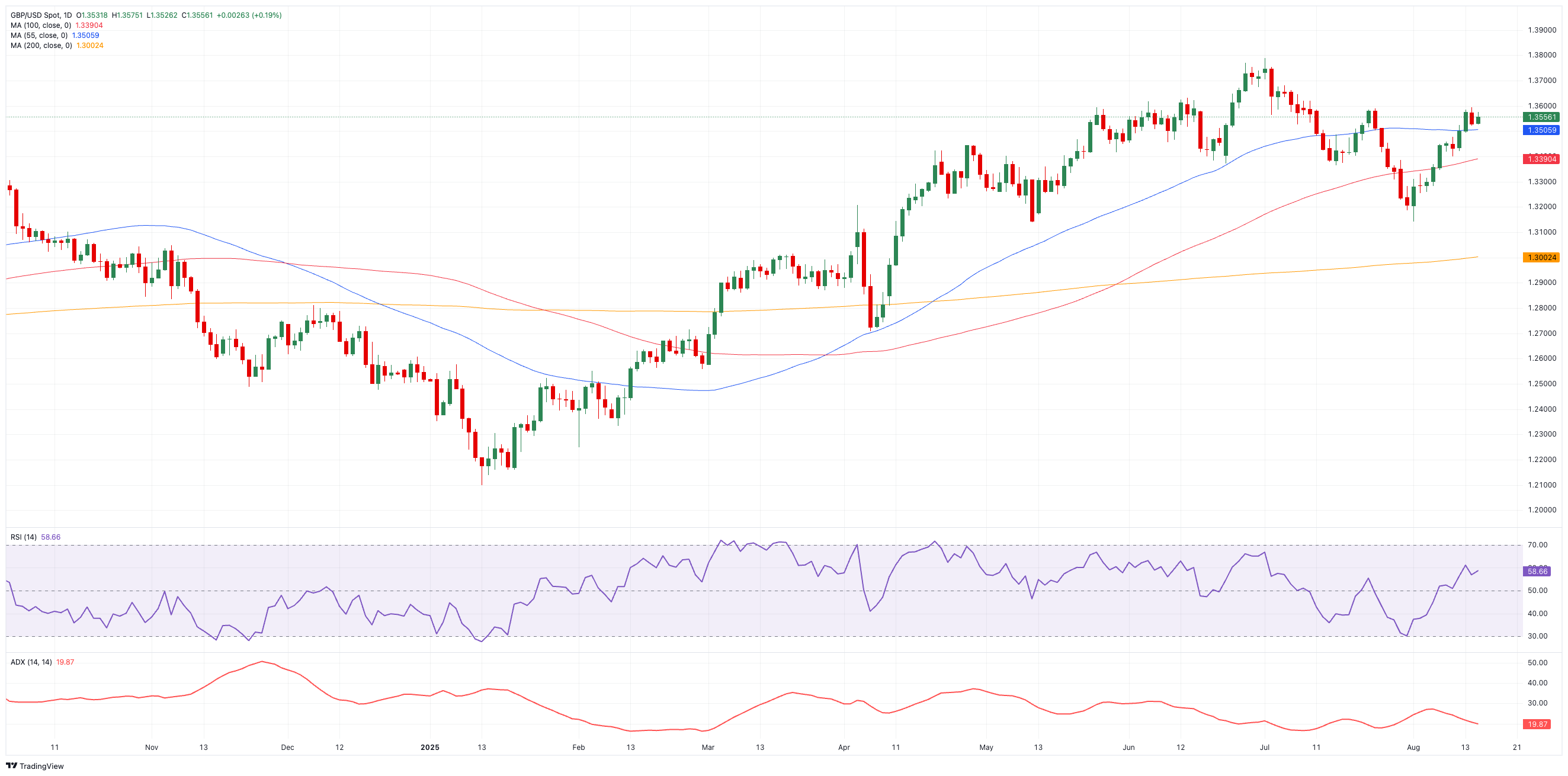
- The Pound Sterling clinched its second week in a row of gains, nearing 1.3600.
- The cautious stance from the Bank of England continues to support the currency.
- Investors’ attention now gyrates to the release of crucial UK inflation figures.
The Pound Sterling (GBP) extended its multi-day march north against the US Dollar (USD) this week, lifting GBP/USD to levels just shy of the 1.3600 hurdle. The uptick in Cable was also underpinned by the equally strong recovery in 10-year gilt yields, which rose to levels last seen in early June, past 4.70% on Friday.
The US Dollar and the BoE underpin the rally
GBP/USD closed in the red in only two days since the beginning of August, gaining more than 4 cents since lows around 1.3140 recorded on August 1, and currently navigating around the 38.2% Fibo retracement of the July-August steep decline.
Cable’s strong rebound comes in part due to the renewed weakness surrounding the Greenback so far this month, as progress on the trade front, coupled with expectations of further rate cuts by the Federal Reserve (Fed), left the US Dollar on the defensive. In the same direction, persistent threats from US President Donald Trump to the Fed’s independence also added an extra layer of bearishness to the currency’s near-term outlook.
Contributing to the pick-up in the upside impulse of the British Pound, the latest close decision by the Bank of England (BoE) to lower its policy rate to 4.00% seems to have kicked back the spectre of a more aggressive easing cycle.
In fact, the ‘Old Lady’ finds itself caught in a tug-of-war, with both markets and its own policymakers split on what could come next.
On one side, the United Kingdom’s (UK) labour market has been losing steam, squeezed by Chancellor Rachel Reeves’ recent employer tax hike and fallout from US President Trump’s trade war. On the other, inflation is moving in the wrong direction. The BoE has lifted its forecast for a September peak to 4% from 3.7%, warning that rising prices — especially for food — could feed into wage demands and embed longer-term cost pressures.
Furthermore, in its latest projections, the central bank pushed back its timeline for returning inflation to the 2% target, now not expected until Q2 2027 — three months later than previously thought.
Meanwhile, markets now price in nearly 28 basis points of easing through the March 2026 monetary policy meeting, consistent with roughly a quarter-point rate cut in the next seven months.
What’s next for GBP?
On the domestic calendar, all the attention is expected to be on the publication of the July Inflation Rate, seconded by the preliminary gauges of business activity in the form of S&P Global Manufacturing and Services PMIs.
Expanding the view, the Jackson Hole Symposium should keep the central banks’ galaxy at the centre of the debate, with Chief Jerome Powell due to speak on August 22 and BoE’s Governor Andrew Bailey on August 23.
Also of note will be the release of the FOMC Minutes of the July 29-30 meeting, as well as usual comments from Fed officials.
What are techs saying?
GBP/USD is expected to meet its next up barrier at its August top at 1.3594 (August 14). The surpassing of that level would pave the way for Cable to confront the weekly peak at 1.3588 (July 24), ahead of its 2025 ceiling at 1.3788 (July 1).
On the flip side, there is an interim support at the 100-day SMA at 1.3386, seconded by the August base of 1.3141 (August 1), which is closely followed by the May floor at 1.3139 (May 12). A breach below the latter would shift focus to the psychological 1.3000 threshold.
In the meantime, while above its 200-day SMA at 1.3003, GBP/USD should maintain its constructive outlook well in place.
Momentum indicators look mixed: The Relative Strength Index (RSI) near 60 keeps the door open to extra gains in the short-term horizon, although the Average Directional Index (ADX) below 20 is indicative that the trend lacks juice for now.
GBP/USD daily chart

All in all
Latest UK GDP figures showed the domestic economy is not faring as badly as many have expected, although the broader outlook remains far from bright. This, coupled with stubbornly elevated inflation and somewhat cooling labour market conditions, should keep bolstering the current cautious stance from the BoE going forward. And there is the fiscal front, with Chancellor Reeves in the eye of the storm. The British Pound should remain comfortable navigating against this backdrop, although bouts of instability surrounding trade and the potential Fed’s policy path carry the potential to make any march north in the quid at least bumpy for the time being.
BoE FAQs
The Bank of England (BoE) decides monetary policy for the United Kingdom. Its primary goal is to achieve ‘price stability’, or a steady inflation rate of 2%. Its tool for achieving this is via the adjustment of base lending rates. The BoE sets the rate at which it lends to commercial banks and banks lend to each other, determining the level of interest rates in the economy overall. This also impacts the value of the Pound Sterling (GBP).
When inflation is above the Bank of England’s target it responds by raising interest rates, making it more expensive for people and businesses to access credit. This is positive for the Pound Sterling because higher interest rates make the UK a more attractive place for global investors to park their money. When inflation falls below target, it is a sign economic growth is slowing, and the BoE will consider lowering interest rates to cheapen credit in the hope businesses will borrow to invest in growth-generating projects – a negative for the Pound Sterling.
In extreme situations, the Bank of England can enact a policy called Quantitative Easing (QE). QE is the process by which the BoE substantially increases the flow of credit in a stuck financial system. QE is a last resort policy when lowering interest rates will not achieve the necessary result. The process of QE involves the BoE printing money to buy assets – usually government or AAA-rated corporate bonds – from banks and other financial institutions. QE usually results in a weaker Pound Sterling.
Quantitative tightening (QT) is the reverse of QE, enacted when the economy is strengthening and inflation starts rising. Whilst in QE the Bank of England (BoE) purchases government and corporate bonds from financial institutions to encourage them to lend; in QT, the BoE stops buying more bonds, and stops reinvesting the principal maturing on the bonds it already holds. It is usually positive for the Pound Sterling.
Information on these pages contains forward-looking statements that involve risks and uncertainties. Markets and instruments profiled on this page are for informational purposes only and should not in any way come across as a recommendation to buy or sell in these assets. You should do your own thorough research before making any investment decisions. FXStreet does not in any way guarantee that this information is free from mistakes, errors, or material misstatements. It also does not guarantee that this information is of a timely nature. Investing in Open Markets involves a great deal of risk, including the loss of all or a portion of your investment, as well as emotional distress. All risks, losses and costs associated with investing, including total loss of principal, are your responsibility. The views and opinions expressed in this article are those of the authors and do not necessarily reflect the official policy or position of FXStreet nor its advertisers. The author will not be held responsible for information that is found at the end of links posted on this page.
If not otherwise explicitly mentioned in the body of the article, at the time of writing, the author has no position in any stock mentioned in this article and no business relationship with any company mentioned. The author has not received compensation for writing this article, other than from FXStreet.
FXStreet and the author do not provide personalized recommendations. The author makes no representations as to the accuracy, completeness, or suitability of this information. FXStreet and the author will not be liable for any errors, omissions or any losses, injuries or damages arising from this information and its display or use. Errors and omissions excepted.
The author and FXStreet are not registered investment advisors and nothing in this article is intended to be investment advice.




